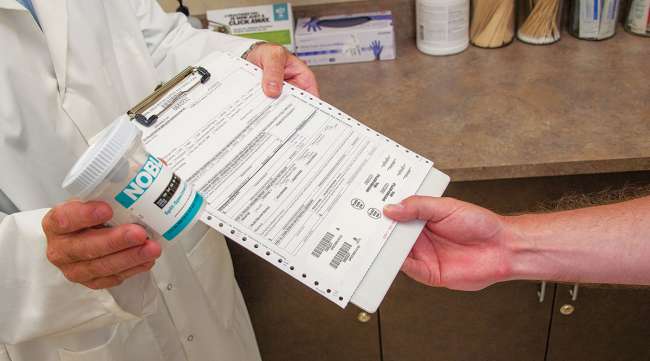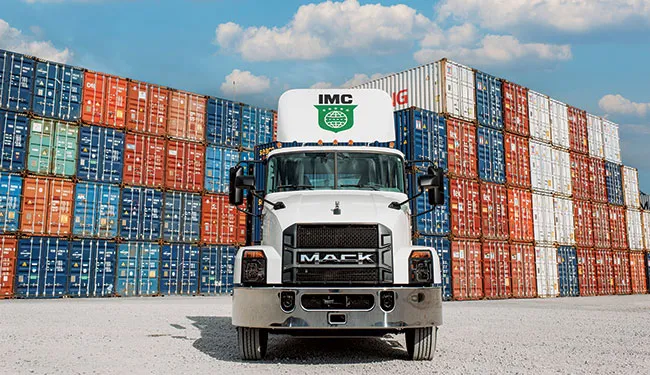Drug Clearinghouse Creates Advantages, Challenges for Industry

[Stay on top of transportation news: Get TTNews in your inbox.]
Although the Federal Motor Carrier Safety Administration’s efforts in streamlining the driver verification process are helping fleets reduce their risk via the Drug & Alcohol Clearinghouse, it also has reduced the pool of qualified drivers, which could shrink further when new requirements take effect Nov. 18.
“The Clearinghouse’s intention is to make sure the roads are safer and to identify drivers with failed drug and alcohol tests early,” said Mike Precia, CEO of Fleetworthy Solutions. “The challenge is the number of people it impacts.”
P. Sean Garney, co-director of Scopelitis Transportation Consulting, said fleets are using the Clearinghouse exactly as intended — to verify that their drivers are not disqualified from operating a commercial motor vehicle for prohibited conduct related to drug and alcohol use and misuse.
As of Jan. 1, 158,330 drivers were in prohibited status, meaning they could not drive a commercial motor vehicle until they completed the required return-to-duty process. “Only about 30% of the drivers with violations in the Clearinghouse have begun this process and have had their privileges restored,” Garney said.

Garney
Also, there are still fleets not complying with the rule. Last year, safety investigations of motor carriers resulted in over 10,500 Clearinghouse-related violations, including over 2,000 for failing to register with the Clearinghouse, Garney said. “On roadside last year, almost 5,400 drivers were placed out of service for violations listed in the Clearinghouse, meaning prohibited drivers are still driving.”
On Nov. 18, FMCSA will start notifying state licensing agencies when a driver licensed in a state is newly prohibited in the Clearinghouse. States will then begin downgrading the CDL and removing commercial driving privileges.
All traffic safety enforcement officers will be able to identify prohibited drivers by conducting a license check during a traffic stop. “It will no longer limit it to just roadside inspectors during a CVSA inspection,” said Kathy Close, an editor with J.J. Keller & Associates.
The shift will pressure drivers with unresolved violations in the Clearinghouse to act rather than wait. Close said the preamble to the final rule noted about 5,000 drivers will have to work with the DMV each year due to downgraded CDLs. “What it will do is remove those drivers who are trying to hide a violation without seeking evaluation and treatment,” she explained.
Robert Brower, assistant vice president of safety and risk management at IMC, said that the deadline could help push drivers who want to remain in the industry to complete a substance abuse program and return-to-duty drug test.
Jeremy Reymer, founder of DriverReach, said the requirement shouldn’t affect the recruiting or qualifying process. “If it works as it should, it will expedite the visibility of drivers who have failed a drug test instead of it being at the mercy of the mandatory annual query that a carrier needs to conduct on their current driver pool,” he said, adding that there could be implementation delays at the state level.
Fleet Support
Fleets said they support the regulation. “The Drug & Alcohol Clearinghouse was created to ‘close the loop’ on drivers that are in violation and/or using illegal drugs while operating a CMV,” said Jason Bolton, director of safety and compliance for Averitt Express. “While the program isn’t perfect, it’s far better than what we had prior.”

Bolton
He added that it will be difficult for drivers to fly under the radar with the drug and alcohol regulations, which is not only better for hiring and regulatory compliance but also safer for the motoring public.
Tracy Rushing, executive director of safety and human resources for RE Garrison Trucking, said the Clearinghouse has given carriers more certainty that information is accurate and helps them make better decisions. She expects to see more drivers in a prohibited status beginning in November, but it won’t change the fleets’ operations. “Our practices and guidelines will stay the same because the expectations stay the same,” Rushing said.
However, challenges still remain. Precia said carriers are now tasked with managing the Clearinghouse and ensuring they’re compliant while running their business. “It is another thing to manage on top of the long list of things they have to manage,” he said, adding that the Clearinghouse requires queries at the time of hire and then annually based on the initial query date. “It is a rolling 12 months. If you don’t have a single pane of glass keeping track of when you’re hiring drivers, it is easy to get off cadence.”

Robert Brower of IMC says the November deadline could push drivers who want to remain in the industry to complete a substance abuse program and return-to-duty drug test. (IMC)
Brower noted that by creating automated workflow processes, IMC has been able to make these requests seamless through its internal onboarding and compliance systems. Even still, Rushing noted that employers often find themselves waiting for drivers, and one issue is getting drivers to log in to the Clearinghouse. “They struggle more with getting their credentials to work rather than giving you consent,” she said.
Candi Coate, north regional safety manager for Highway Transport, said drivers have to take time upfront to enroll and register in the Clearinghouse, but once that’s completed, it helps reduce how much time it takes for an employer to verify compliance. To help avoid hiring delays, DriverReach prompts drivers to complete their Clearinghouse registration when they submit an application.
Another concern for carriers is knowing what and when the employer must report certain violations. “When a medical review officer is not involved, the employer must report a violation,” J.J. Keller’s Close explained. “Since MROs only report failed drug tests, employers also report negative return-to-duty tests and when the follow-up program is complete.”
Carriers must adhere to a three-day time frame for reporting violations, which Brower said can be problematic. “Some situations are not as cut and dry and take research from both the designated employee rep and medical review officer to ensure accuracy,” he said.
Even passwords can cause headaches. “When someone who was the account administrator leaves the carrier, the new person might not have the password. They have to go through the Clearinghouse IT department. It can take time, which means they could be late on their queries,” Close said.
For overall security, Garney said it is essential to periodically audit who in the company has access to the Clearinghouse and update that information at least annually. “As a part of this, employers should verify who in their team received notifications of changes and ensure they know what to do when they are provided this information,” he explained.

Coate
Coate said the No. 1 challenge is the reduction of qualified CDL drivers. She explained, concerning the retention side, that it’s more critical now that “we keep our finger on the pulse with driver satisfaction and continue to find creative ways to reduce turnover rates.”
To help raise awareness, Precia recommended that fleets educate drivers through drug and alcohol training. “It starts with making sure the carriers have a policy in place that is firm and serious. That trickles down to everything they’re doing when coaching and interacting with drivers,” he said. “We have to make sure people with CDLs understand those decisions can affect their ability to earn.”
Close recommends carriers include information about the loss of driving privileges in the information they share with drivers and establish policies around violations and hiring. “Always consider state and federal employment laws when hiring,” she said. “There are employment laws that prevent you from discriminating against someone who has been rehabilitated.”
Many employers terminate drivers who fail drug tests or are prohibited in the Clearinghouse. “This is a problem because the rules generally require drivers to have an employer sponsor to complete the return-to-duty process, and it can be difficult to find a new employer if the Clearinghouse shows the driver cannot legally operate a CMV,” Garney explained.
Return to Duty
Returning to duty requires several steps, including finding and engaging a certified substance abuse professional for a driver evaluation, following a prescribed education or treatment program, passing a return-to-duty test and completing a follow-up testing program that includes six random follow-up tests over 12 months.
Carriers may be able to move employees to other positions while they are working to return to duty. “They could work in the yard or somewhere else as they’re waiting to become eligible,” Precia said.

Rushing
RE Garrison Trucking works with drivers completing the return-to-duty process. “They can call and say, ‘I just need a carrier to take a chance on me, hear my story, read my review and see my follow-ups,’” Rushing said. “It is scary for a carrier to do that, but we’re going to rely on the SAP professional and their opinion.”
The fleet has almost no turnover with the drivers they work with on follow-up testing. “You have to spend a good bit more time with that driver getting more information. It builds their confidence in you and your confidence in them,” she continued.
Drivers are responsible for the cost of completing the process. “We always pass that follow-up cost back to the driver,” Rushing said. “It is your return to duty, your program and your rehabilitation.”
Many in the industry remain concerned about how marijuana, which truck drivers are prohibited from consuming under federal law, will affect the driver pool.
“Marijuana accounts for nearly 60% of positive drug tests. With more and more states legalizing or decriminalizing marijuana, prohibited drivers in these states may be choosing professions that don’t prohibit them from consuming marijuana,” Garney said, adding that the restriction may change in the long run, as the Department of Health and Human Services has recommended that the Drug Enforcement Agency move marijuana from a Schedule 1 to Schedule 3 drug.
Volvo's Chayene de Souza and Magnus Gustafson discuss how new, connected trucks can boost business, enhance safety practices, and reinforce preventative maintenance plans. Tune in above or by going to RoadSigns.ttnews.com.
Close said some see using marijuana as equivalent to having a casual drink, which is why she believes education is critical. “I think there are opportunities to make it very clear for drivers,” she said.
Rushing thinks fleets should emphasize drivers’ critical role in the economy. “We have to say, ‘You’re a master craftsman, and we need you to do what you do,’” she said. “‘Professional drivers can earn over $100,000 a year.’ The tone had to be, ‘Really? Is this the choice you’re going to make?’”
Overall, the long-term value of the Clearinghouse is in keeping habitual drug or alcohol users from entering or remaining in the industry, making it safer for everyone and, to some extent, streamlining the process, according to Garney.
Carriers agree. “Imagine if we didn’t have this resource? Those drivers would still be on the roadway. Think on that,” Bolton said.
Precia said the key with the Clearinghouse is for carriers to invest in the resources that will help them remain compliant with existing and new regulatory requirements as they emerge. “If they don’t have someone on staff or a vendor partner that is constantly keeping their finger on the pulse of regulatory changes, I would recommend they do that.”
If carriers still need to register with the Clearinghouse, Reymer said they need to do it immediately. “Even if you don’t hire anybody, you have to run queries every year. If you’re not, you’re in violation of multiple rules.”
Want more news? Listen to today's daily briefing below or go here for more info:





